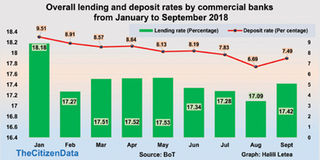Why interest rates on loans plunged

What you need to know:
- BoT reports have shown a declining trend in interest rates charged on loans and offered to deposits by commercial banks since the start of this year
Dar es Salaam. The Bank of Tanzania (BoT) has disclosed that interest rates charged on loans and offered to deposits by commercial banks were on a downward trend in the first nine months of this year.
According to BoT’s monthly economic reviews, lending rates have averaged 17.46 per cent in the first eight months of 2018.
The lowest rate of 17.09 per cent was recorded in August while the highest was 17.53 per cent in May.
BoT attributes the decline to an accommodative monetary policy stance and measures of improving information asymmetry such as using credit reference database.
That happened at a time when BoT set a benchmark interest rate based on the monetary policy framework for stability.
To promote credit growth, the BoT revised its discount rate of lending money to the commercial banks, On August 7, 2017, the central bank lowered the discount rate to 9.0 per cent from 12 per cent before revising it to a historic low of 7.0 per cent in August, 2018.
“This review reflects the need to promote credit growth for supporting economic activities,” the central bank said on August 25 in a circular signed by deputy governor of Economic and Financial Policies.
“The revised discount rate has also taken into account the prevailing monetary policy stance and recent developments in the 91-day and 182-day Treasury bills yields,’’ the circular said.
The business consultant and managing director of TMS Consulting Ltd, Mr Sebastian Kingu, said the initiatives of reducing the discount rate by the central bank is meant to revamp the banking sector, which has been struggling for a couple of years due to an increase of Non-Performing Loans (NPLs).
“Currently most borrowers face challenges on the rate of borrowing because they have to pay more than they generate with some ending up shutting down their businesses while others deciding to sell their assets to pay back their loans,” he said.
The latest review by BoT came at a time when personal loans got the largest pie of commercial banks’ total credit for various economic activities.
Now, lenders have shifted to salaried workers to increase their profits amid declining yields in government securities and increased default rates by other economic activities.
During the past six months, BancABC, Ecobank, PBZ, National Bank of Commerce, CRDB Bank and NMB Bank announced reductions in interest rates on personal loans.
CRDB Bank Plc on May 11 announced rate cuts from 22 to 17 per cent. That was followed by a similar announcement by NMB Bank, which reduced its rates from 19 per cent to 17 per cent for salaried workers.
Finance Manager at the People’s Bank of Zanzibar Limited Mr Musa Juma told The Citizen during an interview that banks were reducing lending rates to attract more depositors.
An analysis of the banking sector for the period ended September 30, 2018 by the Dar es Salaam Stock Exchange-listed broker Zan Securities has noted: “Positive loan growth and advances by commercial banks to customers grew during the period due to decreased lending rates. It seems the decision of the BoT to lower interest rates to seven per cent is starting to bear fruit.”
According to their report, many banks have recorded a decline in NPLs during the quarter as most of them took several measures against bad loans.
NMB Bank Plc once again diverged from its peers with increasing NPLs, albeit, a small increase.
Meanwhile, the overall time deposit rate in the period of six months has averaged 8.22 per cent.
However deposit rates have been on a declining trend. In January, the borrowing rate was 9.51 per cent and declined to 7.49 per cent in September.
The lowest per cent of 6.69 was observed in August this year.
Tanzania is home to nearly 60 commercial banks, but the banking industry’s profit fell from Sh438 billion in 2015 to Sh423 billion in 2016 and Sh286 billion last year.
The industry was forced to retrench many staff after the situation worsened.
By June, 2018, nearly 400 jobs were lost as banks focused on internal consolidation to remain afloat when nonperforming loans bit.


